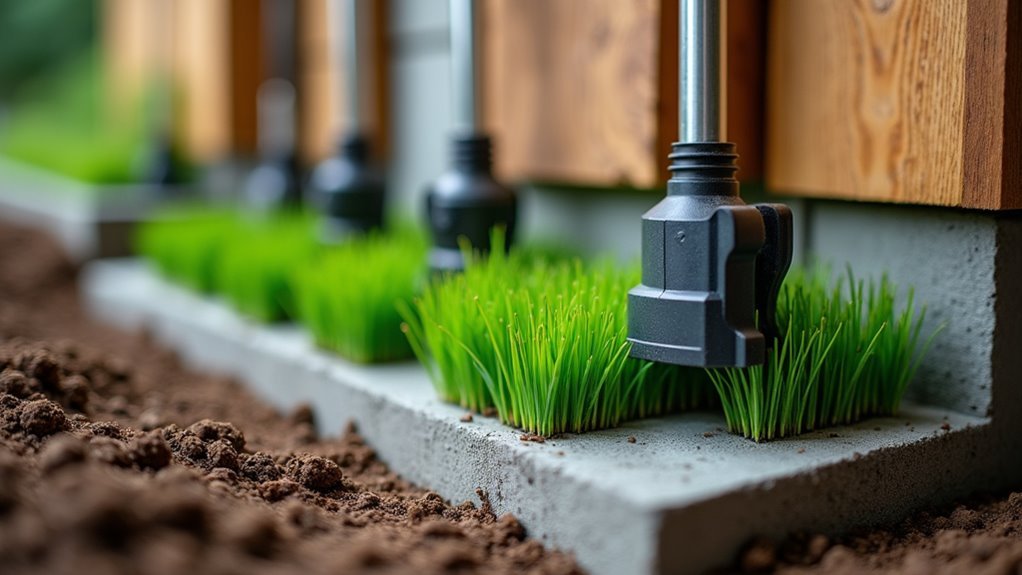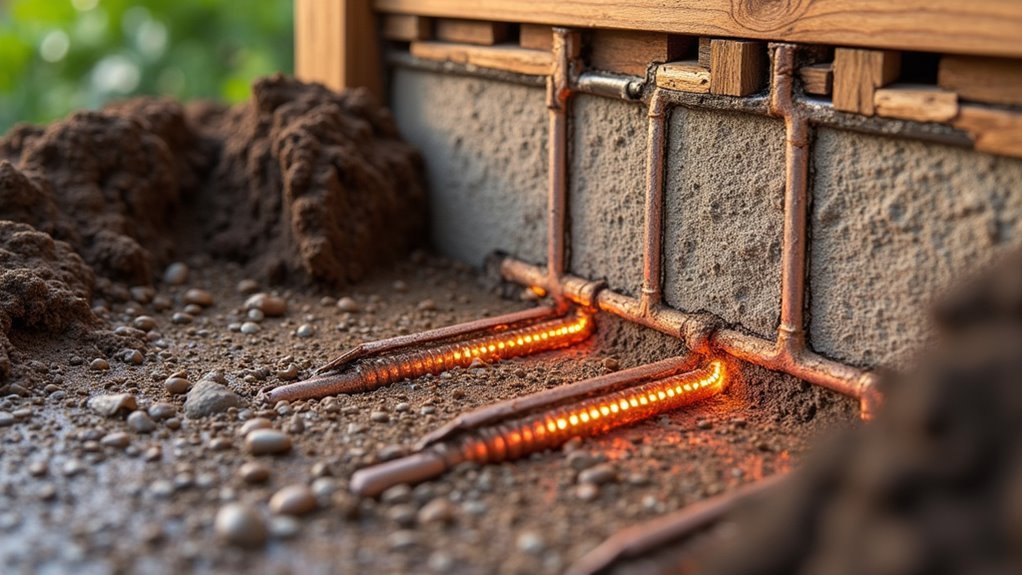A foundation pest protection system creates a chemical barrier around your home’s perimeter to prevent pests from entering through cracks, gaps, and foundation entry points. It targets common invaders like ants, spiders, cockroaches, rodents, and termites by coating vulnerable areas with protective insecticides. These systems require regular applications to manage existing infestations and deter future ones, maintaining a pest-free environment year-round. This extensive guide will reveal everything you need to know about implementing effective foundation protection.
Understanding Foundation Pest Protection Systems and How They Work

Millions of homeowners struggle with unwanted pests infiltrating their living spaces, but a Foundation Pest Protection System offers a strategic defense by creating an impenetrable chemical barrier around your home’s perimeter.
This targeted approach focuses on foundation pest protection by applying specialized insecticides along your home’s base, where pests typically attempt entry.
The system works by coating potential pest entry points with protective chemicals that eliminate common household pests like ants, spiders, and roaches on contact.
You’ll create a barrier around vulnerable areas including foundation cracks, gaps, and joints where insects commonly penetrate.
Regular applications guarantee continuous protection, effectively managing existing infestations while deterring future invasions.
This proactive strategy helps you maintain a pest-free environment year-round, particularly during peak pest activity seasons when infestations are most likely to occur.
Common Pests That Target Home Foundations
Your home’s foundation attracts a diverse range of persistent invaders, each with unique behaviors and entry strategies that make them particularly challenging to control.
Ants establish extensive colonies near structures while searching for food sources, making your foundation an ideal staging ground.
Spiders, including dangerous black widows, seek shelter in foundation cracks and crevices.
Cockroaches exploit even the smallest foundation gaps to infiltrate your home and create rapid infestations.
Rodents like mice and rats burrow close to foundations, using any available openings to access nesting sites and food.
Termites pose the greatest threat, feeding on wood and cellulose materials to cause serious structural damage that’s expensive to prevent and repair.
Key Components of an Effective Foundation Barrier System

You’ll need two main components to build an effective foundation barrier system against pests.
Physical barrier methods form your first line of defense by sealing entry points and blocking access routes.
Chemical treatment applications create your second layer of protection by establishing invisible perimeter barriers that deter and eliminate pests.
Physical Barrier Methods
While chemical treatments form one layer of defense, physical barrier methods create the foundational backbone of any thorough pest protection system.
You’ll protect your home more effectively by installing metal or heavy-duty plastic sheeting around your foundation to block pest entry points.
To implement a complete approach that minimizes pest activity, focus on these essential elements:
- Proper barrier installation – Seal all gaps meticulously to prevent pests from exploiting openings
- Strategic soil grading – Direct water away from your foundation to reduce moisture attraction
- Regular inspection schedules – Monitor for wear or damage that compromises barrier integrity
- Integrated treatment strategy – Combine barriers with chemical methods to keep pests away effectively
This multi-layered system greatly reduces infestation likelihood while maintaining long-term protection.
Chemical Treatment Applications
Chemical treatments work hand-in-hand with physical barriers to create an impenetrable defense system around your foundation.
These chemical treatment applications utilize residual insecticides that maintain their effectiveness for extended periods, specifically targeting ants, spiders, and cockroaches before they enter your home.
You’ll need to focus application on critical entry points around your foundation where pest activity typically occurs. This targeted approach stops pest infestations at their source rather than dealing with them inside your home.
Regular maintenance guarantees your chemical barrier remains effective as seasonal pest patterns change.
Combining these effective methods with physical pest control measures creates extensive protection.
This dual approach enhances your foundation’s defensive capabilities, providing superior results compared to using either strategy alone for long-term pest management.
Signs Your Home Needs Foundation Pest Protection
How can you tell if your home needs foundation pest protection? Several warning signs indicate it’s time to take action against unwanted invaders threatening your property.
Watch for these key indicators that your foundation requires pest protection:
- Structural vulnerabilities – Cracks, crevices, or gaps around windows, doors, and foundation walls create easy entry points for pests seeking shelter in your home.
- Increased pest activity – More frequent sightings of ants, spiders, or rodents around your home’s perimeter signal an emerging infestation requiring immediate attention.
- Moisture problems – Water accumulation near your foundation from poor drainage or leaky pipes attracts pests and creates ideal breeding conditions.
- Evidence of infestation – Discovering pest droppings or nesting materials indicates an urgent need for thorough foundation protection to prevent further invasions.
Types of Foundation Treatment Methods Available

Once you’ve identified the warning signs indicating your home needs foundation pest protection, understanding your treatment options becomes the next priority. Professional services offer three distinct foundation treatment methods designed to create an effective protective barrier around your property.
| Treatment Method | Application Focus |
|---|---|
| Full Foundation Treatment | Extensive coverage targeting multiple entry points |
| Spot Treatment | Localized pest activity in specific foundation areas |
| Granular Treatment | Foundation line barrier using specialized formulations |
| Targeted Selection | Based on observed pest activity type |
| Regular Application | Maintains long-term protection effectiveness |
Each approach uses specific pest control products tailored to your situation. Full coverage addresses widespread issues, while spot treatments handle minor problems efficiently. Granular applications establish lasting perimeter defense. Regular maintenance of these methods will greatly reduce the likelihood of future infestations by eliminating access routes before pests establish themselves.
DIY Foundation Pest Control Techniques and Materials
While professional treatments offer extensive protection, you can implement several effective DIY foundation pest control techniques using readily available materials.
DIY foundation pest control using common household materials provides homeowners an accessible alternative to costly professional services.
These methods help keep unwanted pests from establishing themselves around your home’s foundation by targeting potential entry points and creating a barrier against infestations.
Essential DIY foundation pest control techniques include:
- Seal cracks and gaps – Apply weather-resistant caulk to visible foundation crevices to eliminate pest entry routes.
- Install physical barriers – Use metal or plastic sheeting around the foundation perimeter for added protection.
- Apply granular insecticides – Distribute pest control products around your foundation, creating a barrier against ants and roaches.
- Maintain cleanliness – Remove debris and properly store firewood away from foundation areas.
Regular inspections complement these pest management strategies for ideal results.
Maintaining Your Foundation Pest Protection System
After implementing these DIY foundation pest control methods, you’ll need to maintain your system regularly to guarantee long-term effectiveness.
Your foundation is the first line of defense against pest intrusions, making consistent upkeep essential. Conduct regular inspections to identify new cracks or gaps that could compromise your barrier. Seal these openings immediately to keep unwanted pests from entering your home.
Apply insect sprays around your foundation perimeter to maintain protective coverage. Ensure proper drainage prevents moisture buildup that attracts pests. Clean debris and organic materials from around your home’s exterior regularly.
Following best practices includes scheduling professional pest control services when needed. These thorough pest solutions work together to maintain an effective foundation protection system year-round.
Moisture Management for Enhanced Pest Prevention
Because moisture serves as the primary magnet for most household pests, controlling water accumulation around your foundation becomes critical for long-term pest prevention.
Effective moisture management protects your home through these essential strategies:
Comprehensive moisture control strategies form the foundation of successful long-term pest prevention for your home.
- Direct drainage paths away from foundation walls to prevent water pooling near your home’s perimeter.
- Install Class I vapor retarders over exposed earth to prevent moisture from penetrating your foundation system.
- Maintain proper ventilation in raised wood floor systems to keep living spaces isolated from ground moisture sources.
- Add flood vents in flood-prone areas to maintain pressure equilibrium and prevent moisture-related pest issues.
When you prevent moisture accumulation, you’re eliminating the conditions that attract unwanted pests.
Experienced professionals recommend combining proper insulation with strategic ventilation to create a healthy living environment that naturally resists infestations.
Long-Term Benefits of Foundation Pest Protection
When you invest in a foundation pest protection system, you’ll see significant cost savings accumulate over the years through reduced extermination treatments and fewer emergency pest control calls.
You’re also protecting your home’s structural integrity by preventing termites, carpenter ants, and other destructive pests from compromising wooden beams, flooring, and foundation elements.
These financial benefits compound over time, making your initial investment pay for itself while preserving your property’s value and safety.
Cost Savings Over Time
While the upfront investment in a foundation pest protection system might seem substantial, you’ll discover considerable cost savings that compound over the years.
This proactive pest management approach delivers measurable financial benefits:
- Structural Protection – You’ll prevent costly repairs from pest damage that can reach thousands of dollars, protecting your foundation, wood framing, and electrical systems.
- Healthcare Savings – A pest-free environment reduces disease exposure risks, potentially lowering medical expenses from pest-related health issues.
- Emergency Service Avoidance – Regular treatments eliminate expensive emergency pest control calls that cost considerably more than preventive measures.
- Property Value Enhancement – Your foundation pest protection system helps enhance overall property value, benefiting future sales or refinancing opportunities while potentially qualifying for insurance discounts.
Structural Damage Prevention
Since termites and other destructive pests cause approximately $5 billion in damages annually across the United States, you can’t afford to ignore your home’s vulnerability to structural damage.
A foundation pest protection system creates an effective barrier around your home, preventing destructive insects and rodents from compromising your property’s structural integrity.
Pests like termites silently destroy wooden components, while rodents gnaw through materials and create entry points for additional problems.
Without proper protection, these invaders cause damage that leads to costly repairs, weakened support beams, and deteriorating foundations.
Regular foundation treatment will help preserve your home’s foundation by addressing threats before they escalate into major structural issues, ensuring you maintain a Pest-Free Home with lasting structural reliability.
Frequently Asked Questions
Is a Pest Control Service Worth It?
You’ll find pest control services worthwhile because they’ll effectively eliminate infestations, prevent costly property damage, improve your indoor air quality, and provide ongoing protection using environmentally responsible methods that’ll save you money long-term.
What Is the Meaning of Pest Protection?
Pest protection means you’re implementing measures to prevent pests from entering your home and causing infestations. You’ll use chemical and physical barriers, regular inspections, and maintenance to keep harmful insects and rodents away.
What Are the Three Main Components of an Effective Pest Prevention Program?
You’ll need three main components for effective pest prevention: regular inspections to identify vulnerabilities, physical barriers like sealing entry points, and chemical treatments that create protective barriers around your home’s foundation.
What Are the Three Basic Rules to Keep an Operation Pest Free?
You’ll maintain a pest-free operation by following three basic rules: eliminate food sources through proper storage and cleanliness, remove water sources by fixing leaks, and block entry points by sealing cracks.
In Summary
You’ll protect your home’s foundation and save thousands in future repairs by investing in a quality foundation pest protection system. Don’t wait until you notice damage or infestations – prevention costs far less than remediation. Whether you choose DIY methods or professional installation, you’re making a smart investment in your property’s value and your family’s comfort. Start with proper moisture control and build your defense system from there.





Leave a Reply